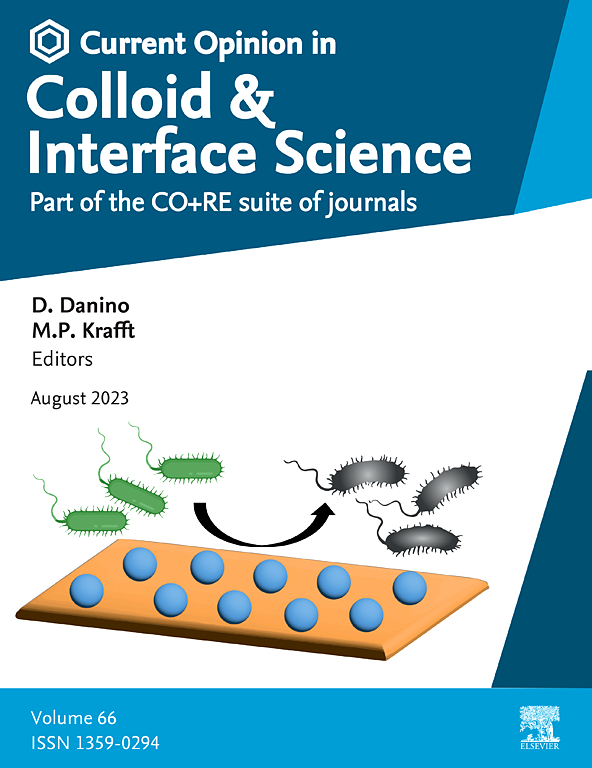Confocal Raman spectroscopy applied to microemulsions and nanoemulsions
IF 7
2区 化学
Q1 CHEMISTRY, PHYSICAL
Current Opinion in Colloid & Interface Science
Pub Date : 2025-05-24
DOI:10.1016/j.cocis.2025.101932
引用次数: 0
Abstract
Raman spectroscopy is a light scattering technique in which a molecule scatters incident light at different wavelengths depending on the chemical structure of the analyte, from a high-intensity laser light source. The Raman scattered light is detected to create the Raman spectrum, which is unique to the chemical compounds present in the sample, acting as chemical fingerprints. Since Raman spectrometers can be coupled to a confocal microscope, the selection of regions of interest and a high magnification of the image of the sample can be achieved. Furthermore, 2D and 3D mapping can be generated from thousands of Raman spectra acquired from different positions on the sample, showing the distribution of individual chemical components in the sample. This review summarizes recent advances in the application of confocal Raman spectroscopy to the physicochemical and analytical characterization of microemulsions and nanoemulsions, focusing primarily on topical formulations and biological studies (in-vitro and ex-vivo), and including representative in-vivo and clinical investigations. Identification, quantification, and distribution of components (surfactants, oil phase, active ingredients, etc.) in the colloidal systems, as well as to biological studies related to dynamic processes of formulations in different tissues, even in real-time, were performed. The methodological aspects of confocal Raman spectroscopy in recent works were adequately described, discussed, and compared. Also, we analyzed the limitations and advantages of the spectroscopic technique, including its contribution to green chemistry. Finally, we discuss future perspectives considering its combination with chemometric and artificial intelligence algorithms to improve the quality of the results.

共聚焦拉曼光谱在微乳液和纳米乳液中的应用
拉曼光谱是一种光散射技术,其中分子散射来自高强度激光光源的不同波长的入射光,这取决于被分析物的化学结构。检测到的拉曼散射光产生了拉曼光谱,这是样品中存在的化合物所特有的,就像化学指纹一样。由于拉曼光谱仪可以耦合到共聚焦显微镜,感兴趣的区域的选择和样品的图像的高放大率可以实现。此外,从样品上不同位置获取的数千个拉曼光谱可以生成二维和三维映射,显示样品中单个化学成分的分布。本文综述了共聚焦拉曼光谱在微乳和纳米乳的理化和分析表征中的应用的最新进展,主要集中在局部配方和生物研究(体外和离体),包括有代表性的体内和临床研究。对胶体体系中的组分(表面活性剂、油相、活性成分等)进行鉴定、定量和分布,并对制剂在不同组织中的动态过程进行生物学研究,甚至进行实时研究。在最近的工作中,共聚焦拉曼光谱的方法学方面得到了充分的描述、讨论和比较。同时,分析了光谱学技术的局限性和优点,以及光谱学技术对绿色化学的贡献。最后,我们讨论了考虑其与化学计量学和人工智能算法相结合以提高结果质量的未来前景。
本文章由计算机程序翻译,如有差异,请以英文原文为准。
求助全文
约1分钟内获得全文
求助全文
来源期刊
CiteScore
16.50
自引率
1.10%
发文量
74
审稿时长
11.3 weeks
期刊介绍:
Current Opinion in Colloid and Interface Science (COCIS) is an international journal that focuses on the molecular and nanoscopic aspects of colloidal systems and interfaces in various scientific and technological fields. These include materials science, biologically-relevant systems, energy and environmental technologies, and industrial applications.
Unlike primary journals, COCIS primarily serves as a guide for researchers, helping them navigate through the vast landscape of recently published literature. It critically analyzes the state of the art, identifies bottlenecks and unsolved issues, and proposes future developments.
Moreover, COCIS emphasizes certain areas and papers that are considered particularly interesting and significant by the Editors and Section Editors. Its goal is to provide valuable insights and updates to the research community in these specialized areas.

 求助内容:
求助内容: 应助结果提醒方式:
应助结果提醒方式:


